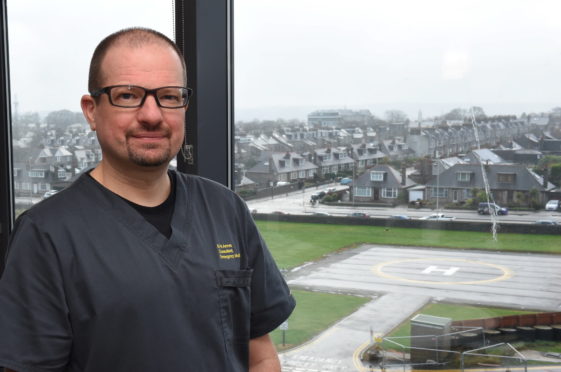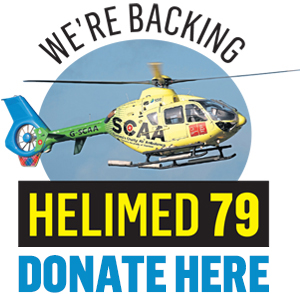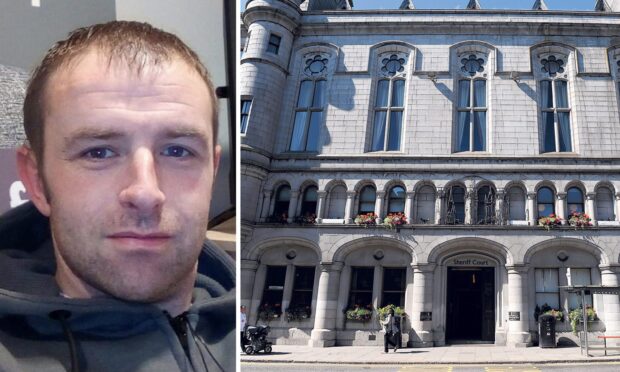A leading doctor at Scotland’s most northern major trauma centre (MTC) has said a charity’s second air ambulance will plug a “gaping hole” in the region.
Dr Roland Armes, a clinical lead at the MTC at Aberdeen Royal Infirmary (ARI) and Royal Aberdeen Children’s Hospital (RACH), claims the city was the “obvious choice” as a base for the new helimed.
Scotland’s Charity Air Ambulance (SCAA) plans to launch its EC135 T2E chopper from Aberdeen airport next spring.
But the charity is still some way from its £6 million fundraising target to fund the aircraft, two pilots, six paramedics and other operational costs.
Dr Armes said Helimed 79 would address a need those in working in north-east emergency medicine have always known was there.
The consultant said: “There is a gaping hole in the north-east in terms of helicopter coverage – and this will even it out.
“This is a resource that will prove really, really, useful and will be key to expanding the work of the Aberdeen MTC.
“The national standard is for patients who suffer major trauma within 45 minutes of an MTC to be taken there.
“This helicopter basically will extend that radius around us – the distance we can cover in that time.
“But that’s true for all of Scotland – the SCAA aircraft is not just for the north-east, it is part of a network.”
The long-awaited MTC in Aberdeen opened, as the first of its kind, in October 2018 in network of other centres in Dundee, Edinburgh and Glasgow.
Within the first year of operations at the north-east’s flagship hospital at Foresterhill, 101 patients were treated for serious trauma injuries.
Nearly 80 patients were taken to the centre, spanning ARI and RACH, by the preferred route – directly from the scene.
The others were transferred from hospitals in Elgin, the Highlands, Orkney and Shetland.
It is these patients Dr Armes thinks will be better served by Aberdeen’s incoming air ambulance.
The 13-year-old aircraft, which is going through a rigorous revamp ahead of taking to region’s skies, will add to an existing trio of air ambulances in Scotland.
Those are the two government-funded ambulance service aircraft in Inverness and Glasgow, and SCAA’s first helicopter in Perth.
“The speed of conveying a patient to hospital can make a really significant difference,” Dr Armes added.
“A lot of things we deal with – including sepsis, cardiac arrest and stroke – are time-based.
“The sooner a heart attack patient is able to access specialist treatment, the better their chance of survival and the better their chance of making a full and good recovery.
“We talk about time being muscle: in that case that muscle is heart.
“Equally, time is brain when dealing with strokes, so the sooner you can get a patient in front a specialist doctor the better.
“In major trauma, it is said that the chances of survival and a good recovery are better the sooner a patient is treated in a place that can resuscitate them.”
Dr Armes said traffic collisions are “without a shadow of a doubt” the biggest contributing factor to their work, with more than 60 MTC patients in Aberdeen being injured on the roads.
Otherwise, more than 10 patients were hurt in falls, around 10 were injured by animals on farms and in sport, and a couple were in industrial accidents.
He added: “We do have a disproportionate amount of rural, distant trauma from us.
“Our road network is different to the Central Belt because you have a few main trunk roads but also a lot of twisty, rural roads.
“Then we have a lot of people into horse riding, cycling and then heavy industry and farming.
“But SCAA isn’t just about trauma, although it’s kind of the sexy thing everyone talks about.
“This helicopter will be advantageous all kinds of patients.”
Scotland’s Charity Air Ambulance has made a huge impact since 2013, saving lives and preventing suffering.
That is why the P&J campaigned successfully for SCAA’s second helicopter to be based in our region.
The countdown is now on for the aircraft – call sign Helimed 79 – to start flying missions from Aberdeen Airport.
But this is an emergency service that relies entirely on donations.
Each call-out costs about £2,500 and SCAA needs P&J readers to help hit its £6million target and get things off to a successful start.
So please do anything you can to raise those funds and show that We’re Backing Helimed 79.
Ways to donate to SCAA
- Website: www.scaa.org.uk/donate
- Text: Text ‘SCAA’ and the amount to 70085
- Phone: 03001231111
- Cheques: Made payable to ‘SCAA’ or ‘Scotland’s Charity Air Ambulance’ and sent to: Scotland’s Charity Air Ambulance (SCAA), The Control Tower, Perth Airport, Scone, PH2 6PL











